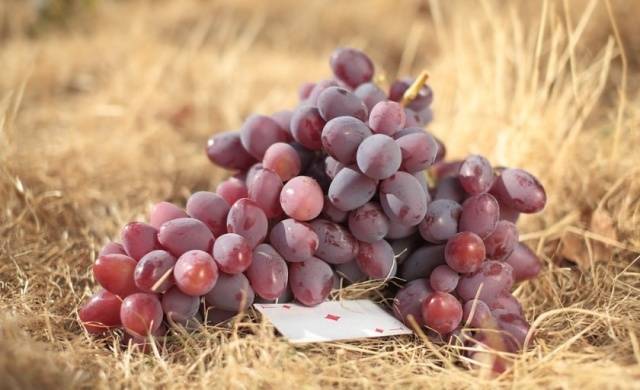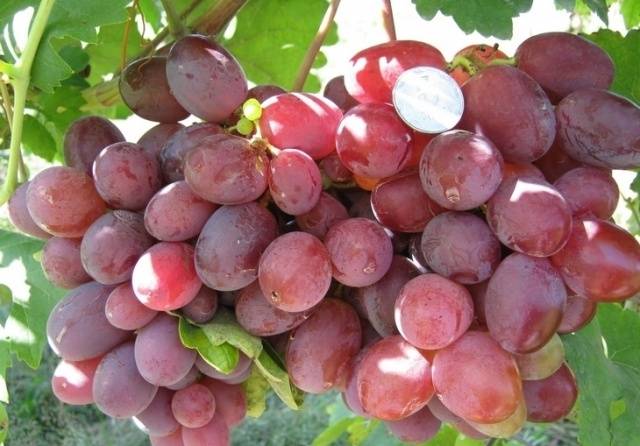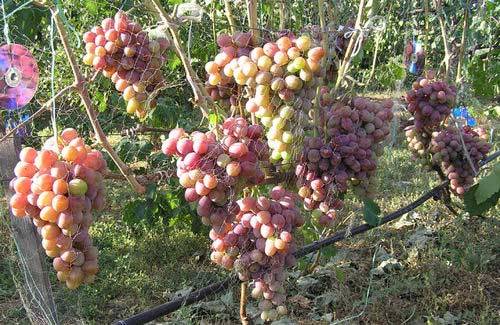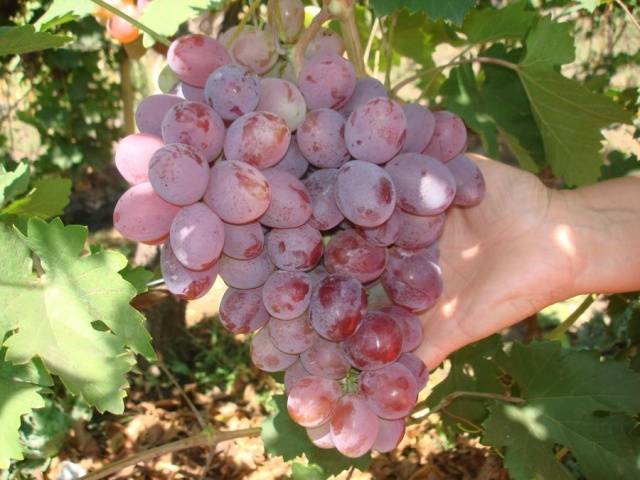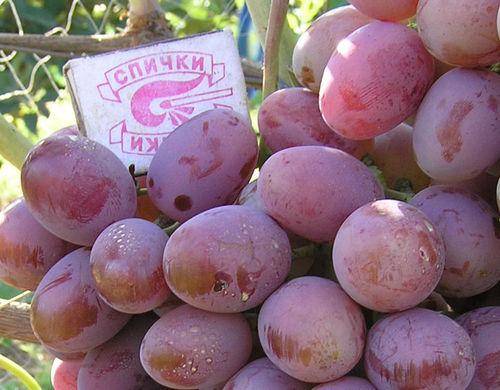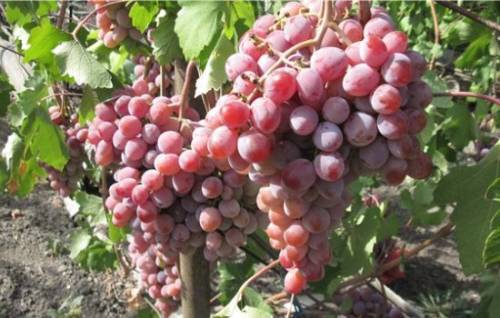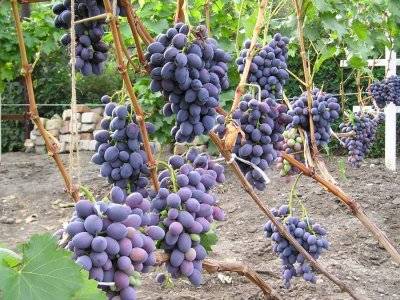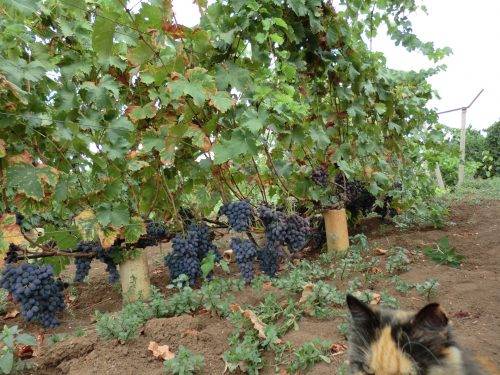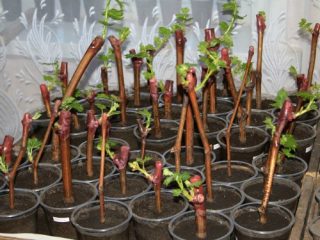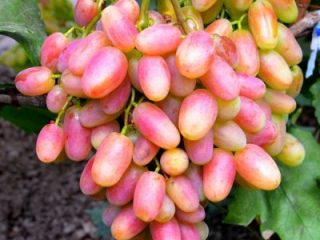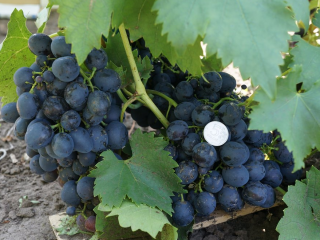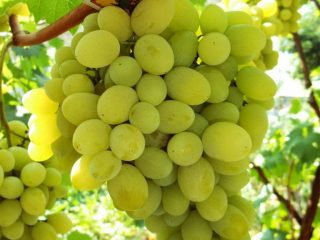Content
In recent decades, not only residents of the southern regions have become “sick” of growing grapes; many gardeners in the middle zone are also trying to plant wine berries on their plots and quite successfully. Many are no longer content with just taste and ease of care, but strive to grow a grape variety with the largest possible berries and clusters. Among the many varieties and hybrid forms of grapes bred in recent decades, the achievements of amateur breeder V.N. are especially famous. Krainova. This article is devoted to a description of the Ataman grape variety, reviews of which are very contradictory, but the photos of the berries are very attractive.
Description of the Ataman variety
The Ataman grape was born as a result of crossing two very popular grape varieties - Talisman and Rizamat. Both parent forms have outstanding characteristics, and Ataman inherited most of them, although he proved to be very susceptible to growing conditions. Rizamat rewarded him with huge berries and high productivity, and from Talisman he inherited stability, good ripening of shoots and rooting of cuttings.
The leaves of the Ataman grape are large in size and have slight pubescence on the lower part of the leaf.The flowers are bisexual, so the bush can be planted even in splendid isolation, and there will still be a harvest. No problems are expected with the propagation of this grape variety, since the cuttings take root well and fusion with the rootstocks during grafting also occurs at the highest level.
In terms of ripening time, the Ataman grape variety is classified as medium or even mid-late - about 130-145 days pass from the moment the buds open to the ripening of the berries. In the south, berries can begin to ripen from the beginning to the first half of September. For more northern regions, ripening dates shift closer to October. The ripening of Ataman grapes can be significantly accelerated by grafting it onto early ripening rootstocks, as demonstrated in the video below.
Ataman bushes have considerable growth power, especially on their own roots. Therefore, crop normalization is mandatory for them, otherwise ripening may be delayed until frost, the vine will not have time to ripen, and the bushes will go into winter unprepared. Not only can this affect the frost resistance of the bushes, but in the next season the vines may refuse to bear fruit at all, trying to restore the strength spent on the excess harvest of the previous year.
The optimal load on an adult bush should be, according to various sources, from 30-40 to 55-60 buds. In this case, fruitful shoots make up 50-65% of the total mass of shoots. The fruiting coefficient is thus equal to 0.9 - 1.1.
It is recommended to prune fruiting vines at 8-10 buds and is best done in the fall, after fruiting has ended, before covering the grape bushes for the winter.In the summer, it is only necessary to cut out individual shoots and stepsons that thicken the bush.
The frost resistance of the hybrid form Ataman is average - the grapes can withstand up to -24°C without shelter. Therefore, in the vast majority of regions of Russia it must be covered for the winter. According to gardeners, these grapes do not tolerate covering with soil in the best way - it is better to use plywood or wooden panels, slate with pine spruce branches and straw as shelters.
One of the advantages of Ataman grapes is its undoubted productivity. Thanks to the rationing of shoots, it can be kept within limits, but this hybrid form is capable of a lot with good care. Many winegrowers easily collect several 10-12 liter buckets of berries from one bush.
Disease resistance of the Ataman grape is the most controversial among those who grow this variety on their plots. According to the breeder, it is average. As for oidium and mildew, resistance is 3 -3.5 points. Indeed, several preventative treatments are often enough for grapes. But regarding various rots, opinions are less favorable. Infections with gray rot are especially common. Many winegrowers note the special tendency of Ataman grapes to crack berries under conditions conducive to this phenomenon: a sharp transition from heat to heavy rains. And through the cracks an infection enters, and the berries begin to rot severely. In addition to preventive treatments with fungicides, these unpleasant moments can be avoided by using a regular moisturizing regime. The ideal solution for industrial plantings would be to install a drip irrigation system.
Characteristics of berries
The clusters and berries of the hybrid form of the Ataman grape are famous, first of all, for their size. According to reviews, some individual berries can reach the size of a good plum.
- The clusters have a predominantly cylindrical-conical shape, sometimes changing into a lobed one.
- The length of the bunches can reach up to 35 cm with a width of about 15 cm.
- The average weight of a bunch is 900-1200 grams, but often reaches 2 kg.
- The density of the brushes is average, sometimes increased.
- The shape of the berries is mainly oval.
- The berries have a beautiful pinkish-red hue; in the sun they darken and become more purple.
- The skin is dense, but quite edible, with a slight waxy coating.
- The pulp is juicy and fleshy.
- The dimensions of the berries are: length -35-40 mm, width - about 25 mm.
- The average weight of one berry is 12-16 grams.
- There are few seeds in the berries - 2-3 pieces.
- The taste of the berries is harmonious, pleasant, without being overly cloying, rather refreshing. Tasters rate it 4.2 points.
According to its purpose, the Ataman grape variety is a table grape. It is of little use for making raisins or homemade wine. - The sugar content in berries is 16-20 g/100 cubic cm, acid content is 6-8 g/cm. dm.
- Damage by wasps is moderate.
- The transportability of grapes is stated to be high. Some people agree with this. For others, this characteristic raises doubts, mainly due to the fact that if the berries crack, then there can be no talk of any transportation.
Reviews from gardeners
As mentioned above, reviews of Ataman grapes are very contradictory. Apparently, this is due to the strong dependence of this hybrid form on growing conditions. It is possible that there are also cases of misgrading.
Grapes Ataman Pavlyuk
There is another hybrid form of grape with a similar name, but with slightly different characteristics. Judging by the description of the Ataman Pavlyuk grape variety, they have a family relationship with the Ataman grape through one of the parents, and from the photo it is clear that the berries are somewhat similar to each other.
Description and characteristics of berries
The Ataman Pavlyuk grape was bred by amateur breeder V.U. Drop by crossing the varieties Talisman and Autumn Black. It also belongs to the mid-late grape varieties, since it usually ripens during September, depending on the growing area.
The growth vigor of the bushes is above average; the vine ripens quite early along the entire length of the growth. Each shoot can bear from two to four inflorescences, so the grapes require rationing. Usually one, maximum two inflorescences are left per shoot.
Resistance to diseases can be called good. Of course, you can’t do without fungicide treatments, but you can get healthy bushes by performing only a few preventative sprays per season.
The yield is good, the bush can pull a very heavy load. The video below clearly shows what this grape variety is capable of.
The bunches can reach significant sizes, up to 2 kg, with an average weight of 700-900 grams. The berries are dark purple, almost black in color. The shape is oval, the size of the berries is large, on average the weight of one berry is 10-12 grams. Pea peas are usually not observed. The taste is very pleasant, sweet with harmonious sourness. The pulp is dense and fleshy.
In suitable conditions, bunches of grapes can easily be stored until the New Year, and some even until spring.
Reviews
For unknown reasons, the Ataman Pavlyuk grape is not particularly popular among winegrowers; it is grown only by a small number of amateurs.Although it does not have particularly outstanding characteristics, those who grow it on their plots are completely satisfied with it and appreciate it for its reliability, productivity and good taste.
Conclusion
Both Ataman and Ataman Pavlyuk grapes are worthy hybrid forms, the greatest value of which is the size of their berries and yield. Of course, each variety has its own nuances in cultivation that must be taken into account. But each gardener chooses for himself which characteristics are more significant for him.
